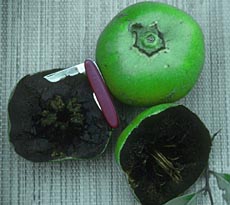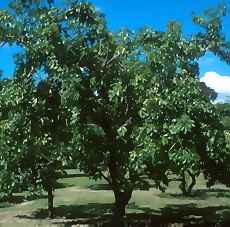You can grow herbs indoors in the winter and add that just-picked taste to your meals, even when snow is drifting up against the kitchen window. You don't even need special lights—herbs fare just fine in a bright window. Here are the best herbs for growing on windowsills and the smart techniques you need to keep them happy and healthy until you can plant outside again.
Basil: Start basil from seeds and place the pots in a south-facing window—it likes lots of sun and warmth.
Bay: A perennial that grows well in containers all year long. Place the pot in an east, or west, facing window, but be sure it does not get crowded—bay needs air circulation to remain healthy.
Chervil: Start chervil seeds in late summer. It grows well in low light but needs 65 to 70 degrees F temperatures to thrive.
Chives: Dig up a clump from your garden at the end of the growing season and pot it up. Leave the pot outside until the leaves die back. In early winter, move the pot to your coolest indoor spot (such as a basement) for a few days, then finally to your brightest window.
Oregano: Your best bet is to start with a tip cutting from an outdoor plant. Place the pot in a south-facing window.
Parsley: You can start this herb from seeds or dig up a clump from your garden at the end of the season. Parsley likes full sun, but will grow slowly in an east, or west, facing window.
Rosemary: Start with a cutting of rosemary, and keep it in moist soilless mix until it roots. It grows best in a south-facing window.
Sage: Take a tip cutting from an outdoor plant to start an indoor sage. It tolerates dry, indoor air well, but it needs the strong sun it will get in a south-facing window.
Tarragon: A dormant period in late fall or early winter is essential for tarragon to grow indoors. Pot up a mature plant from your outdoor garden and leave it outside until the leaves die back. Bring it to your coolest indoor spot for a few days, then place it in a south-facing window for as much sun as possible. Feed well with an organic liquid fertilizer.
Thyme: You can start thyme indoors either by rooting a soft tip cutting or by digging up and potting an outdoor plant. Thyme likes full sun but will grow in an east, or west, facing window.
Rooting a cutting
Many herbs—including oregano, thyme, rosemary, and sage—are best propagated for indoor growing by taking a cutting from an existing outdoor plant. To do it, snip off a 4-inch section, measured back from the tip. Strip off the lower leaves and stick the stem into moist, soilless mix, such as perlite and/or vermiculite. To ensure good humidity, cover with glass or clear plastic, and keep the growing medium-moist.
Transition to indoors
Before the first fall frost (while the weather is still on the mild side), start moving your potted herb plants toward their winter home. Instead of bringing them directly inside, put them in a bright, cool "transitional zone," such as a garage, entryway, or enclosed porch, for a few weeks.
Once they've acclimated, move them to an area with lots of sun (south-facing windows are brightest, followed by east or west views). But protect them from heat and dryness. Most herbs prefer daytime temperatures of about 65 to 70 degrees F, although they can withstand climbs into the 70s. It's especially important that night temperatures drop at least 10 degrees—down into the 50s would be better—to simulate outdoor conditions.
With the exception of basil, they'll even do well with occasional dips into the 40s. (So turn that thermostat down when you go to bed.) Place them outside on mild days, and give them regular baths to wash off dust.
Water, light, and temperature
Most herbs like to be well watered but don't like wet feet. That's why good drainage is important. Water when the top of the container feels dry, or learn to judge the moisture in the soil by the weight of the pot. Add sand or vermiculite to the potting soil to ensure good drainage.
Learn to juggle water, light, and temperature. An herb in a clay pot in a south-facing window will need more water than one in a plastic pot in an east, or west, facing window. If the light is low, keep the temperature low.
Pest prevention
Choose the soil for your indoor herbs carefully. A good commercial potting soil is fine, or for a deluxe mix, blend one part potting soil with one part compost and one part vermiculite, perlite, or sand (or a mixture of all three).
Resist the temptation to use disease- and pest-prone garden soil. And when you pot up garden-grown plants, remove as much of the garden soil as possible without damaging the roots.
Keep such transplants separate from your other houseplants while you're gradually acclimating them to the indoors. If you see insects on a plant during this "quarantine," leave it outside.
If, despite such defenses, your indoor plants do come under insect attack, help the herbs stay healthy by providing the correct mix of light and temperature, and give them regular baths. A plant weakened by hot, dry indoor conditions is even more susceptible to spider mite, whitefly, or aphid damage than a healthy one.
If you choose to use soap sprays to control these pests, remember that the wet spray must come in contact with the insect to be effective. Spray in the evening (and never in bright sunlight) to prevent rapid drying, and wash off residues the next day (or before eating the leaves). Don't spray very young seedlings with soap!
Hold back on the water and fertilizer through December, but when the days start getting longer in mid-January, feed them with liquid seaweed or compost. Even potted soil gets compacted as you water it, so cultivate it with a little fork, then top-dress it with compost.
February is usually a great month for indoor plants because of all the bright light. By March, they are starting to get buds, and in April, be sure to put them outside on a warm day. Then it won't be long before the herbs—and you—are ready to move back to the garden.



